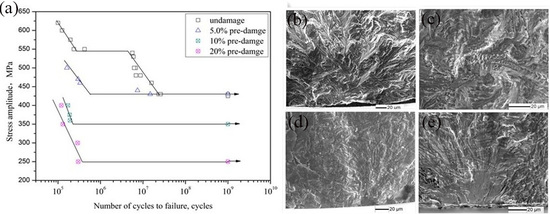Effect of Low Cycle Fatigue Predamage on Very High Cycle Fatigue Behavior of TC21 Titanium Alloy
Abstract
:1. Introduction
2. Experimental Procedures
2.1. Materials
2.2. Surface Treatment
2.3. Fatigue Test
2.3.1. Ultrasonic Fatigue Test
2.3.2. LCF Fatigue Tests
2.3.3. LCF/VHCF Combined Fatigue Tests
2.3.4. Fatigue Precrack Propagation
3. Results
3.1. LCF Damage of TC21 Titanium Alloy
3.2. S-N Curves After Fatigue Predamage
3.3. SEM Observation of the Fracture Surface
4. Discussion
4.1. Effect of LCF Predamage on VHCF Fracture Mechanism
4.2. Effect of Fatigue Predamage on Fatigue Life
5. Conclusions
Acknowledgments
Author Contributions
Conflicts of Interest
References
- Zheng, Y.C.; Zhao, Z.H.; Zhang, Z.H.; Zong, W.M.; Dong, C. Internal crack initiation morphologyistics and early growth behaviors for very-high-cycle fatigue of a titanium alloy electron beam welded joints. Mater. Sci. Eng. A 2017, 706, 311–318. [Google Scholar] [CrossRef]
- Deng, H.; Li, W.; Sakai, T.; Sun, Z. Very high cycle fatigue failure analysis and life prediction of Cr-Ni-W gear steel based on crack initiation and growth behaviors. Materials 2015, 8, 8338–8354. [Google Scholar] [CrossRef] [PubMed]
- Nie, B.; Zhang, Z.; Zhao, Z.; Zhong, Q. Very high cycle fatigue behavior of shot-peened 3Cr13 high strength spring steel. Mater. Des. 2013, 50, 503–508. [Google Scholar] [CrossRef]
- Huang, Z.Y.; Wanger, D.; Bathias, C.; Chaboche, J.L. Cumulative fatigue damage in low cycle fatigue and gigacycle fatigue for low carbon-manganese steel. Int. J. Fatigue 2011, 33, 115–123. [Google Scholar] [CrossRef]
- Huang, Z.Y.; Wang, Q.Y.; Wagner, D.; Bathias, C. Effect of low cycle fatigue predamage on very high cycle fatigue. Theor. Appl. Mech. Lett. 2012, 2, 031007. [Google Scholar] [CrossRef]
- Mayer, H.; Haydn, W.; Schuller, R.; Issler, S.; Bacher-Höchst, M. Very high cycle fatigue properties of bainitic high carbon-chromium steel under variable amplitude conditions. Int. J. Fatigue 2009, 31, 1300–1308. [Google Scholar] [CrossRef]
- Crupi, V.; Epasto, G.; Guglielmino, E.; Squillace, A. Influence of microstructure [alpha + beta and beta] on very high cycle fatigue behaviour of Ti-6Al-4V alloy. Int. J. Fatigue 2017, 95, 64–75. [Google Scholar] [CrossRef]
- LeBiavant, K.; Pommier, S.; Prioul, C. Local texture and fatigue crack initiaton in a Ti-6Al-4V. Fatigue Fract. Eng. Mater. Struct. 2002, 25, 527–545. [Google Scholar] [CrossRef]
- Sinha, V.; Spowart, J.E.; Mills, M.J.; Williams, J.C. Observations on the faceted initiation site in the dwell-fatigue tested ti-6242 alloy: Crystallographic orientation and size effects. Metall. Mater. Trans. A 2006, 37, 1507–1518. [Google Scholar] [CrossRef]
- Ravi Chandran, K.S.; Jha, S.K. Duality of the S–N fatigue curve caused by competing failure modes in a titanium alloy and the role of Poisson defect statistics. Acta Mater. 2005, 53, 1867–1881. [Google Scholar] [CrossRef]
- El Haddad, M.H.; Smith, K.N.; Topper, T.H. Fatigue Crack Propagation of Short Cracks. J. Eng. Mater. Technol. 1979, 101, 42–46. [Google Scholar] [CrossRef]
- Morrissey, R.J.; Golden, P.; Nicholas, T. The Effect of Stress Transients on the HCF Endurance Limit in Ti-6Al-4V. Int. J. Fatigue 2003, 25, 1125–1133. [Google Scholar] [CrossRef]
- Zerbst, U.; Vormwarld, M.; Pippan, R.; Ganser, H.P.; Sarrazin-Baudoux, C.; Madia, M. About the fatigue crack propagation threshold of metals as a design criterion—A review. Eng. Fract. Mech. 2016, 153, 190–243. [Google Scholar] [CrossRef]
- Bathias, C. Piezoelectric fatigue testing machines and devices. Int. J. Fatigue 2006, 28, 1438–1445. [Google Scholar] [CrossRef]
- Lin, X.B.; Smit, R.A. Finite element modelling of fatigue crack growth of surface cracked plates. Part II: Crack shape change. Eng. Fract. Mech. 1999, 63, 523–540. [Google Scholar] [CrossRef]
- Zuo, J.H.; Wang, Z.G.; Han, E.H. Effect of microstructure on ultra-high cycle fatigue behavior of Ti-6Al-4V Materials. Mater. Sci. Eng. A 2008, 473, 147–152. [Google Scholar] [CrossRef]
- Andre, P.; Samuel, F. Effects of inclusions on the very high cycle fatigue behaviour of steels. Fatigue Fract. Eng. Mater. Struct. 2017, 40, 1694–1707. [Google Scholar]
- Morrissey, R.J.; McDowell, D.L.; Nicholas, T. Frequency and stress ratio effects in high cycle fatigue of Ti-6Al-4V. Int. J. Fatigue 1999, 21, 679–685. [Google Scholar] [CrossRef]
- Moshier, M.A.; Nicholas, T.; Hillberry, B.M. Load history effects on fatigue crack growth threshold for Ti-6Al-4V and Ti-17 titanium alloys. Int. J. Fatigue 2001, 23, 253–258. [Google Scholar] [CrossRef]
- Zhao, P.; Cheng, C.; Gao, G.; Hui, W.; Misra, R.D.K.; Bai, B.; Weng, Y. The potential significance of microalloying with niobium in governing very high cycle fatigue behavior of bainite/martensite multiphase steels. Mater. Sci. Eng. A 2016, 650, 438–444. [Google Scholar] [CrossRef]
- Lanning, D.; Haritos, G.K.; Nicholas, T.; Maxwell, D.C. Low-cycle fatigue/high-cycle fatigue interactions in notched Ti-6Al-4V. Fatigue Fract. Eng. Mater. Struct. 2001, 24, 565–578. [Google Scholar] [CrossRef]
- Shi, D.Q.; Luo, Y.Y.; Zhao, P.T.; Yu, H.C.; Yang, X.G. Effect of low cycle fatigue predamage on high cycle fatigue strength of TA11 alloy. J. Aerosp. Power 2016, 31, 257–265. (In Chinese) [Google Scholar]
- Bathias, C.; Paris, P.C. Gigacycle Fatigue in Mechanical Practice; Marcel Dekker: New York, NY, USA, 2005. [Google Scholar]
- Hertzberg, R.W. On the calculation of closure-free fatigue crack propagation data in monolithic metal alloys. Mater. Sci. Eng. A 1995, 190, 25–32. [Google Scholar] [CrossRef]
- Chen, W. Research on the Damage Tolerance of TC21 Titanium Alloy. Ph.D. Thesis, Nanjing University of Aeronautics and Astronautics, Nanjing, China, 2008. [Google Scholar]
- Suresh, S. Fatigue of Materials, 2nd ed.; Cambridge University Press: Cambridge, UK, 1998; pp. 388–392. [Google Scholar]
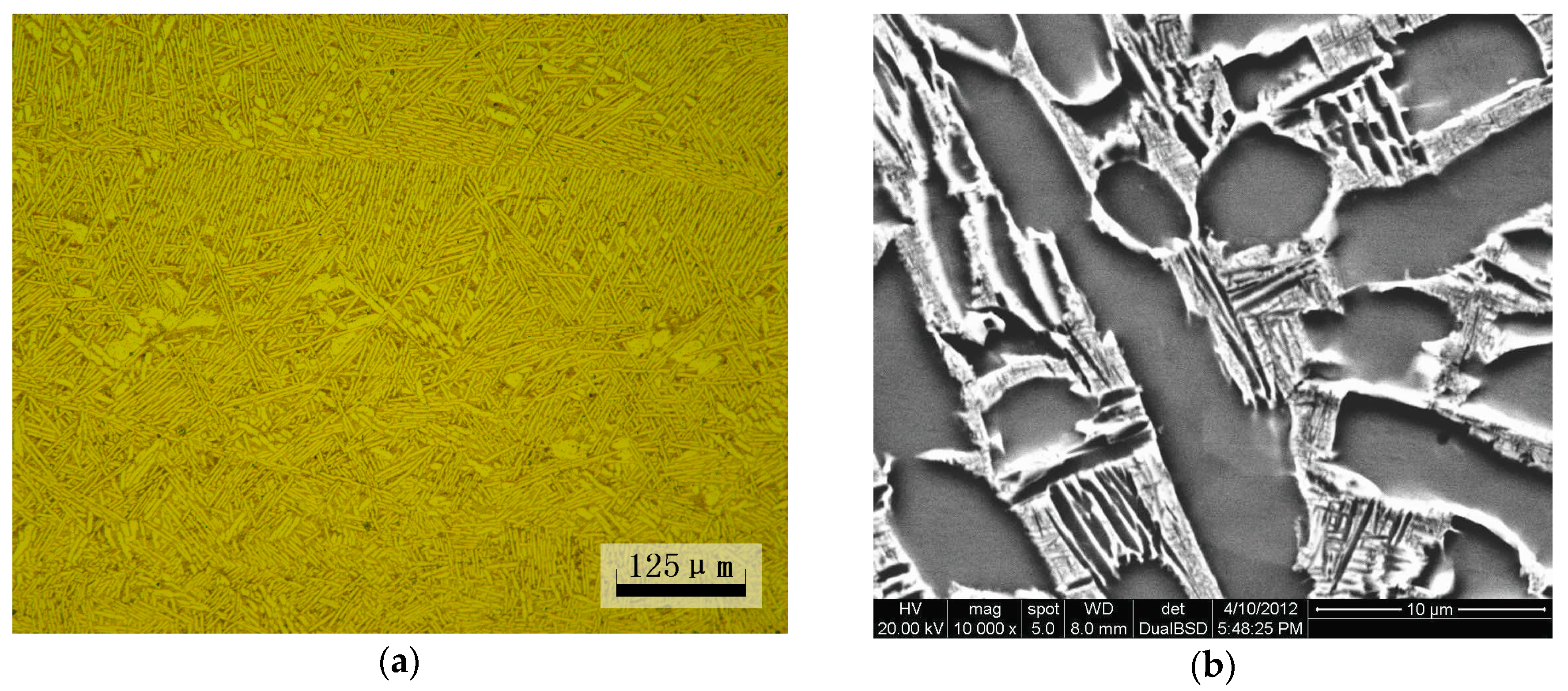

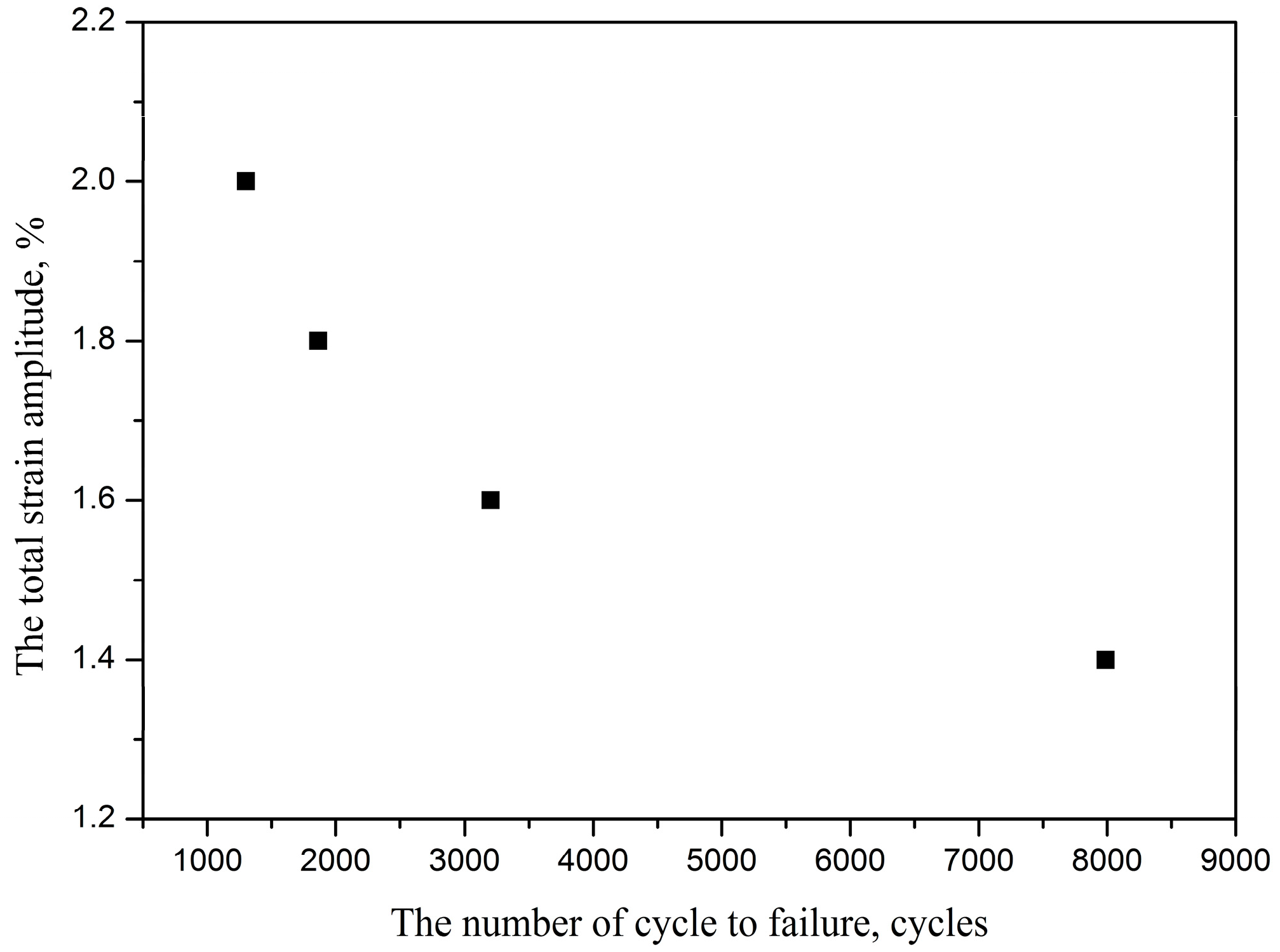

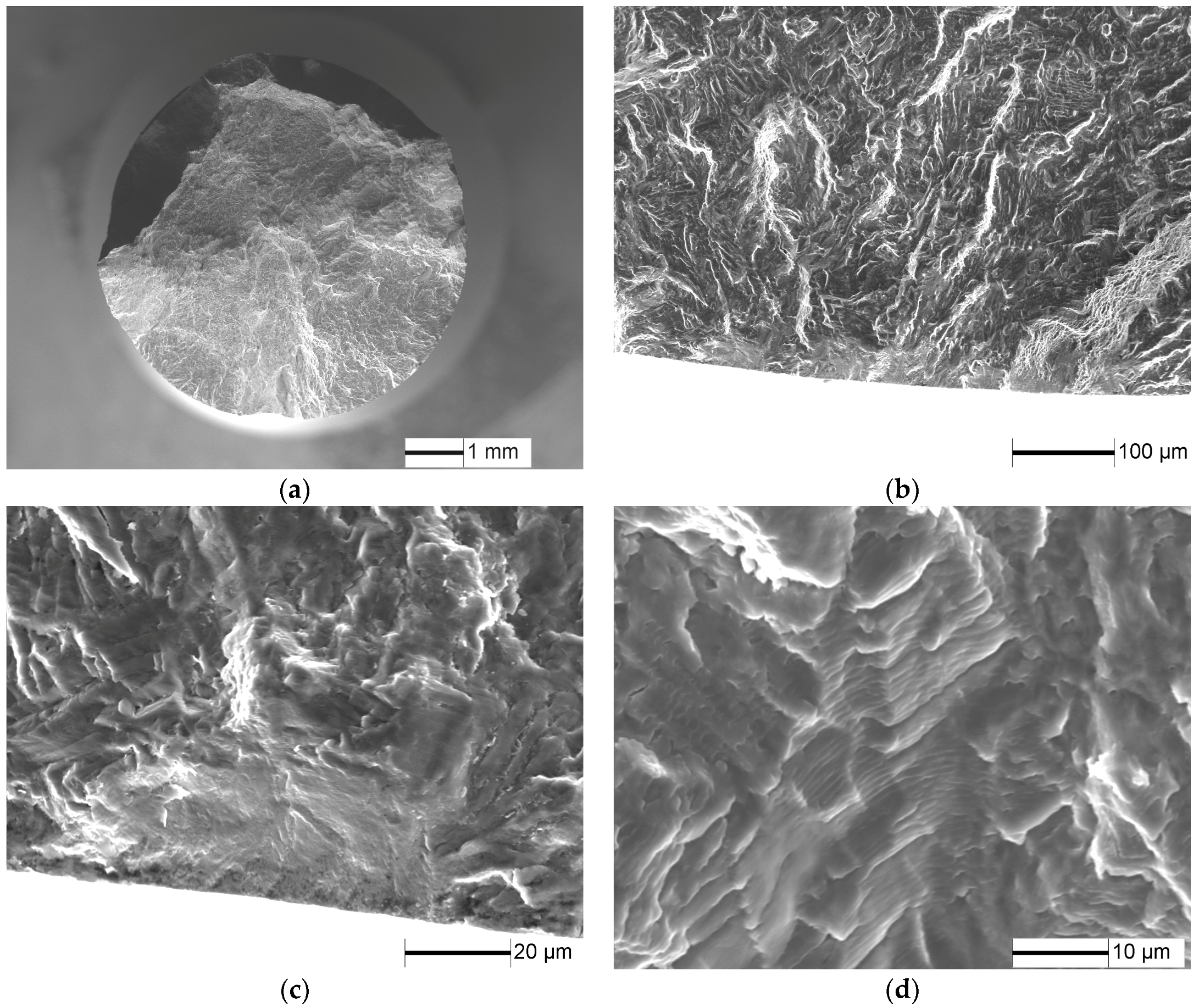
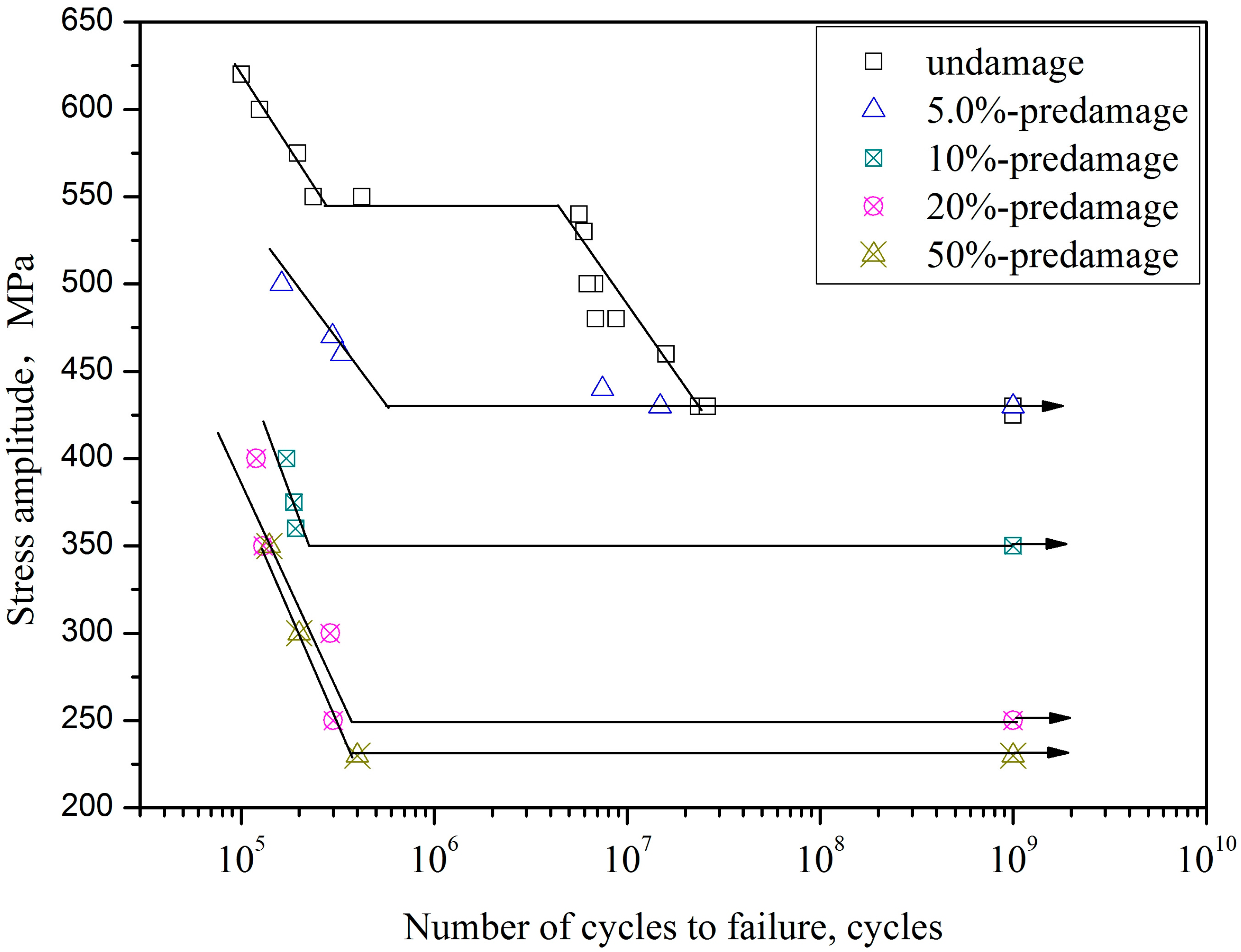
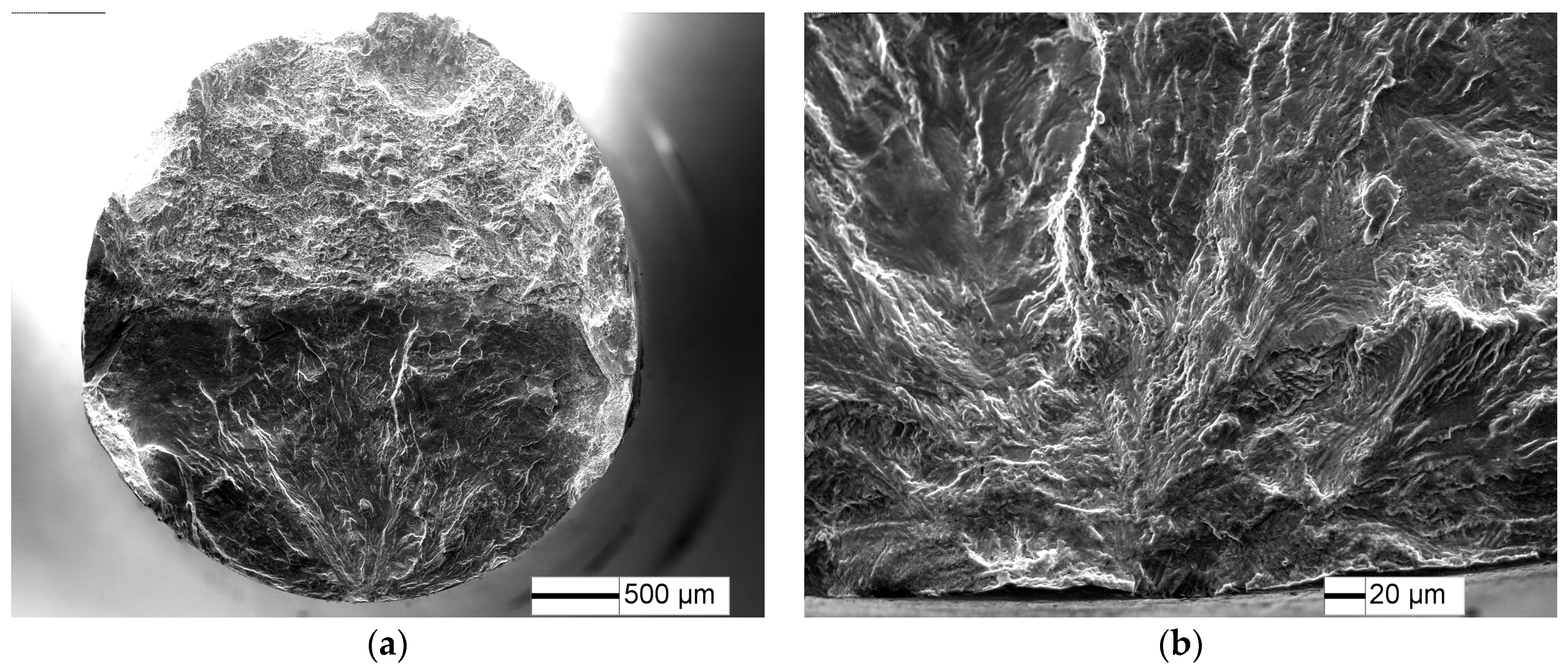
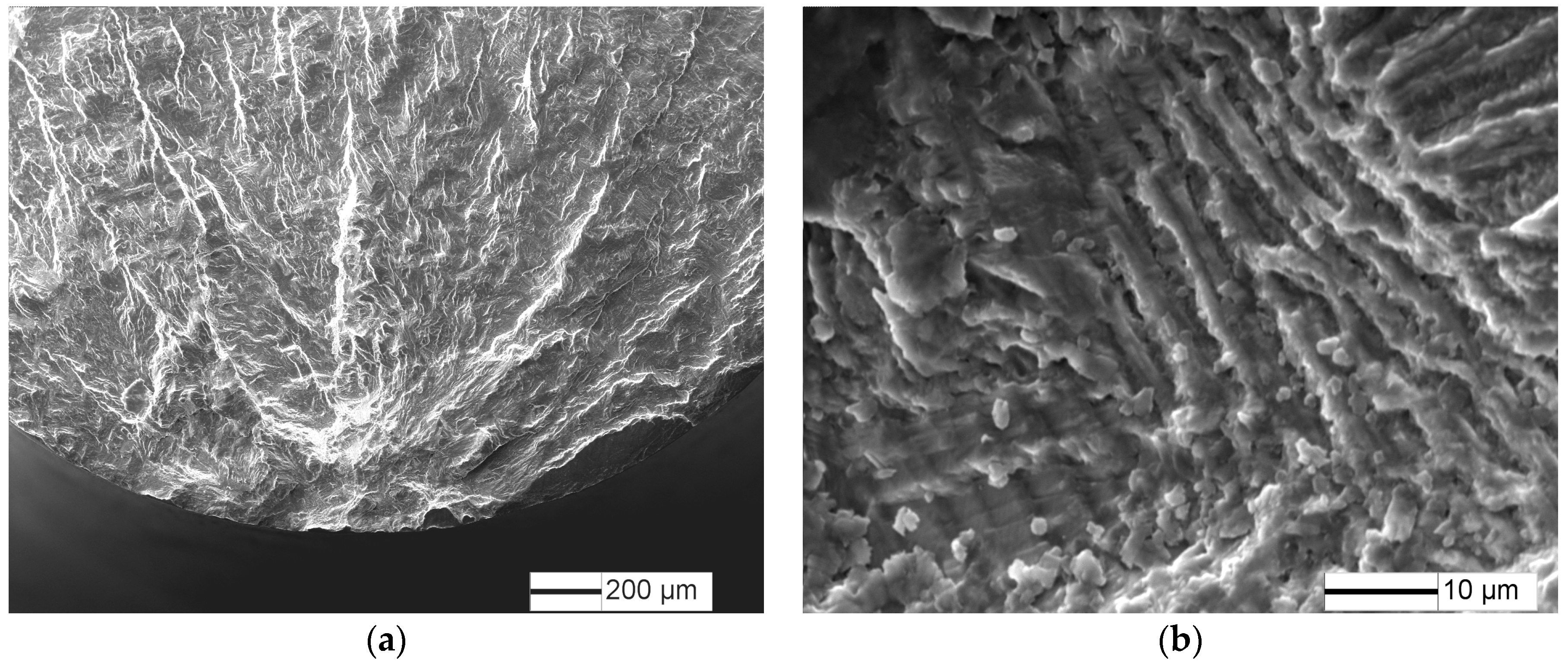

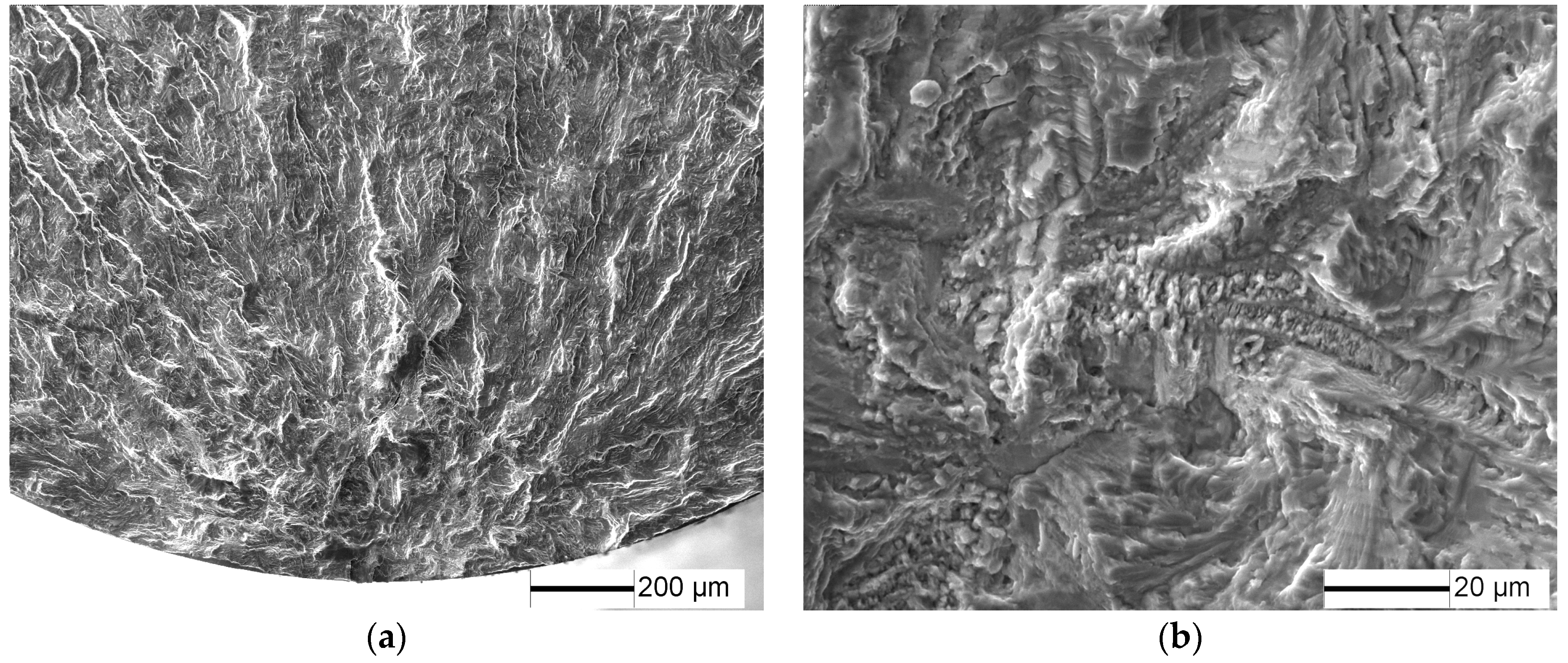
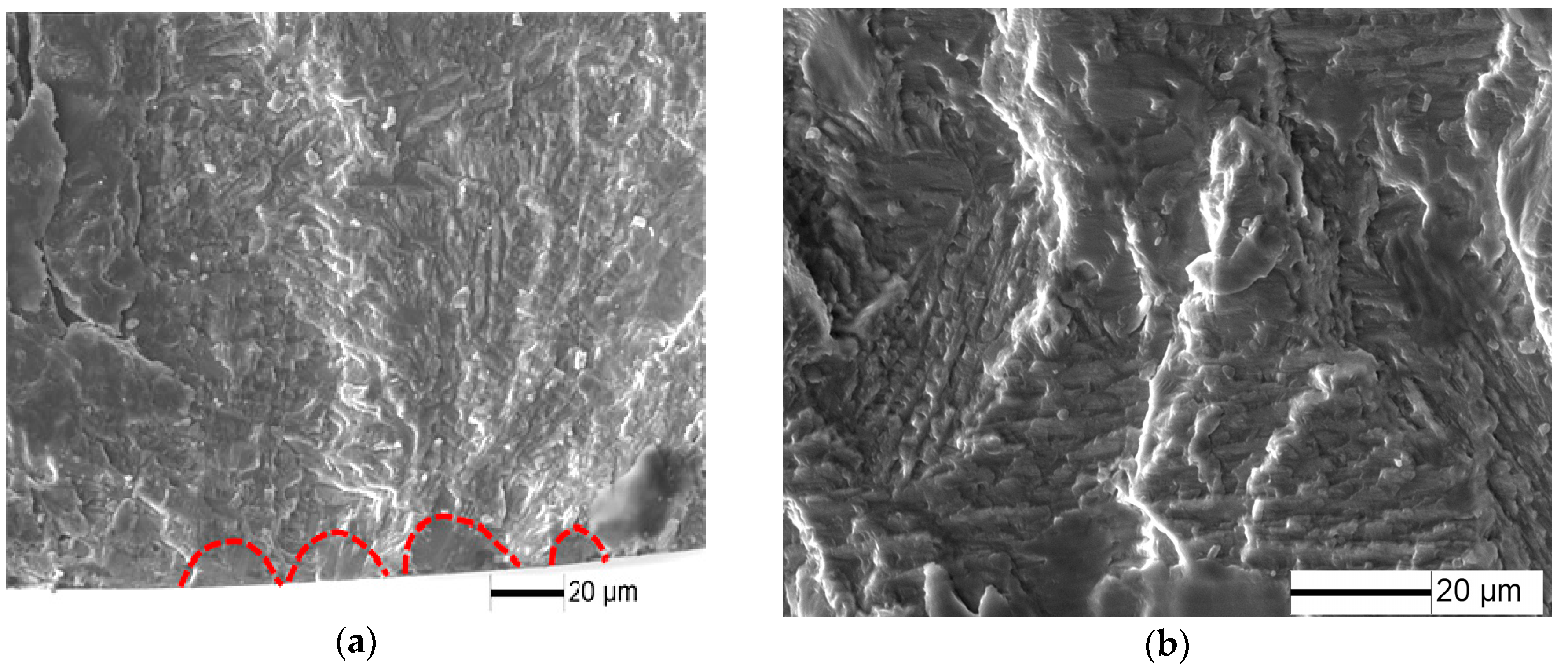
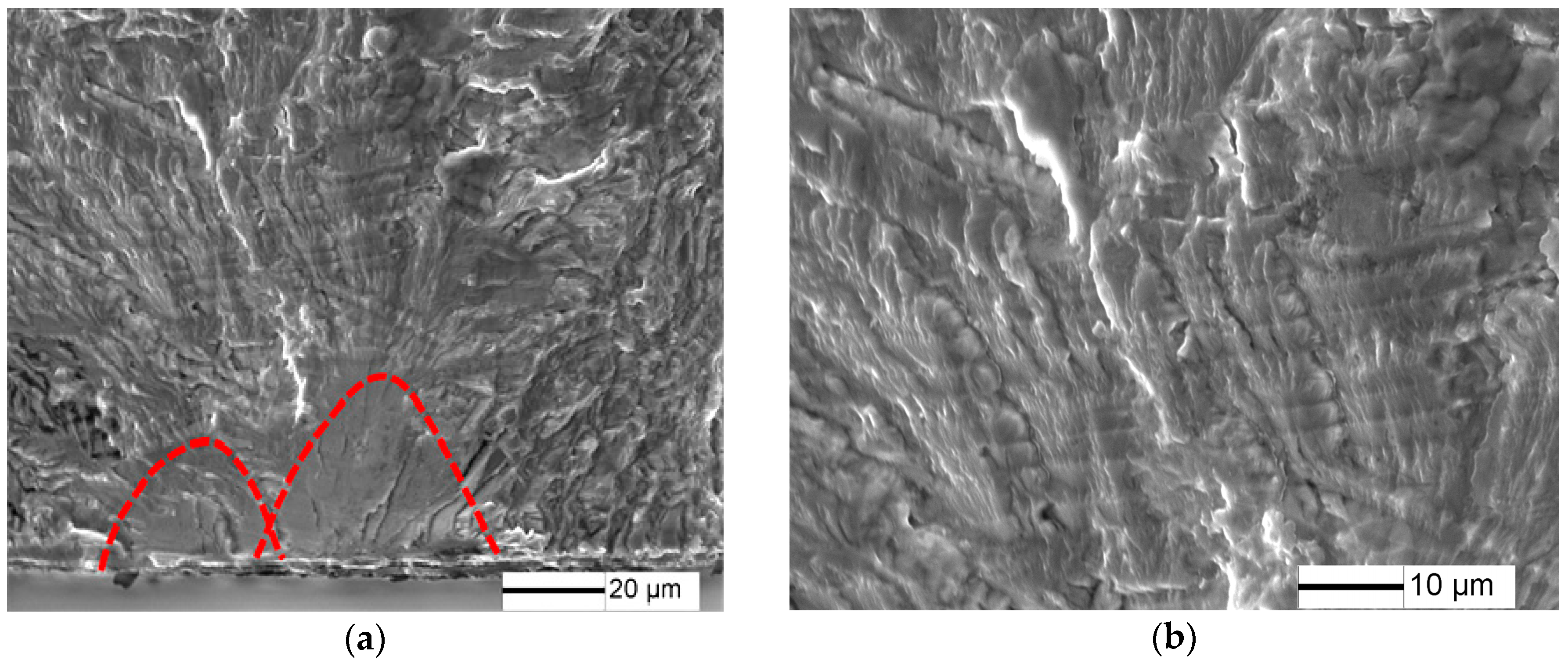

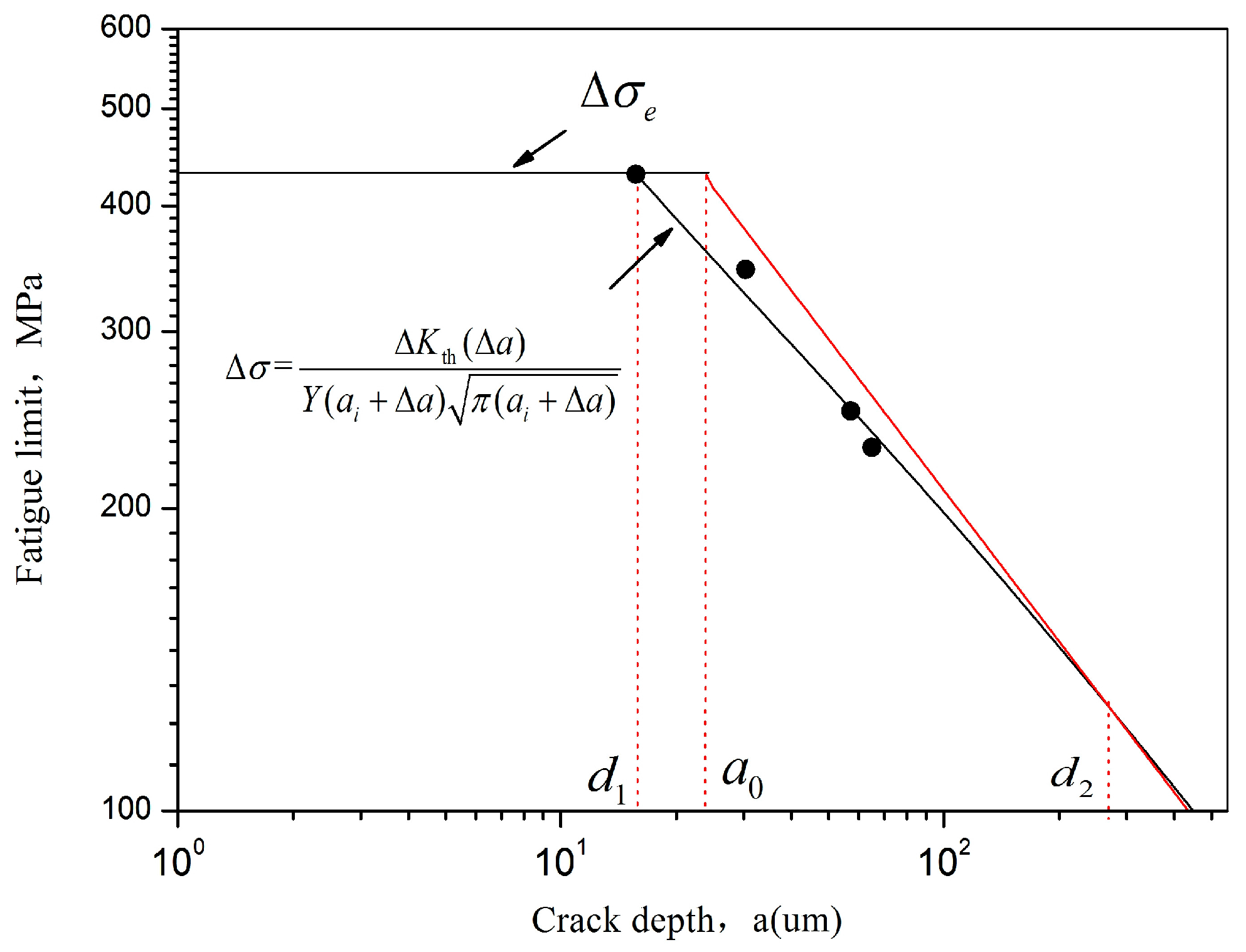
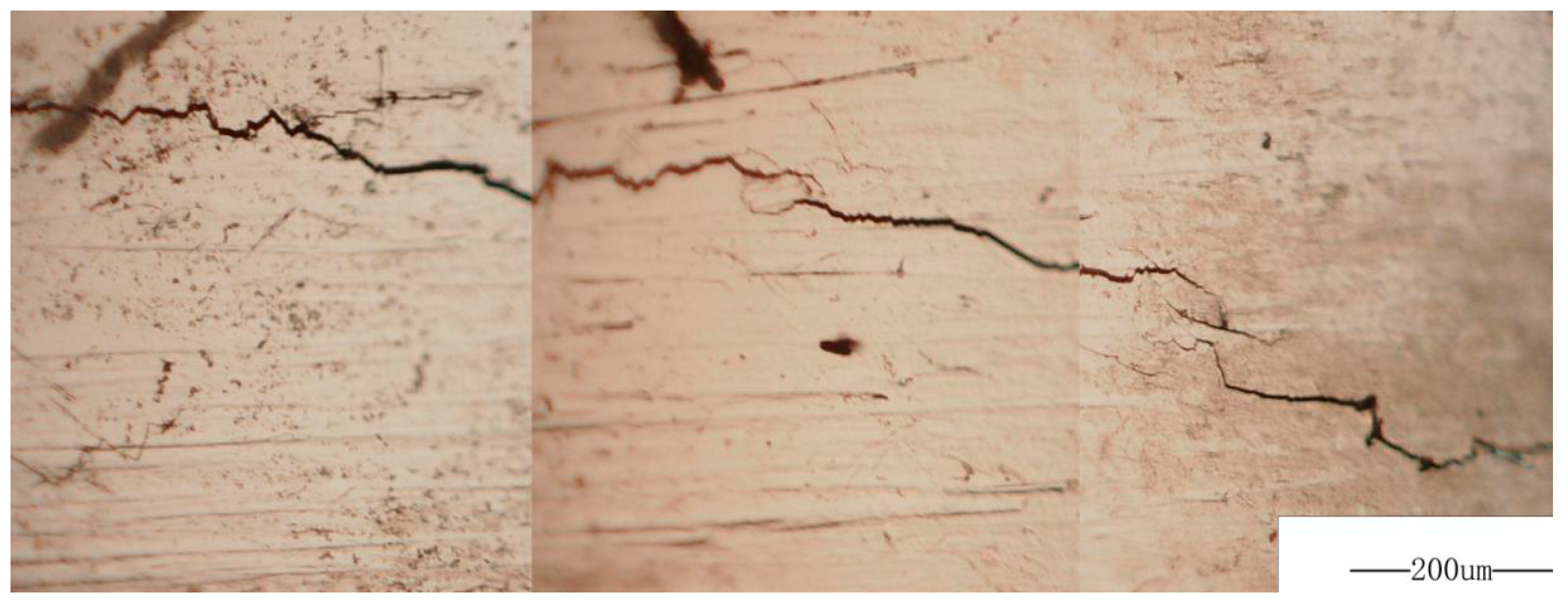
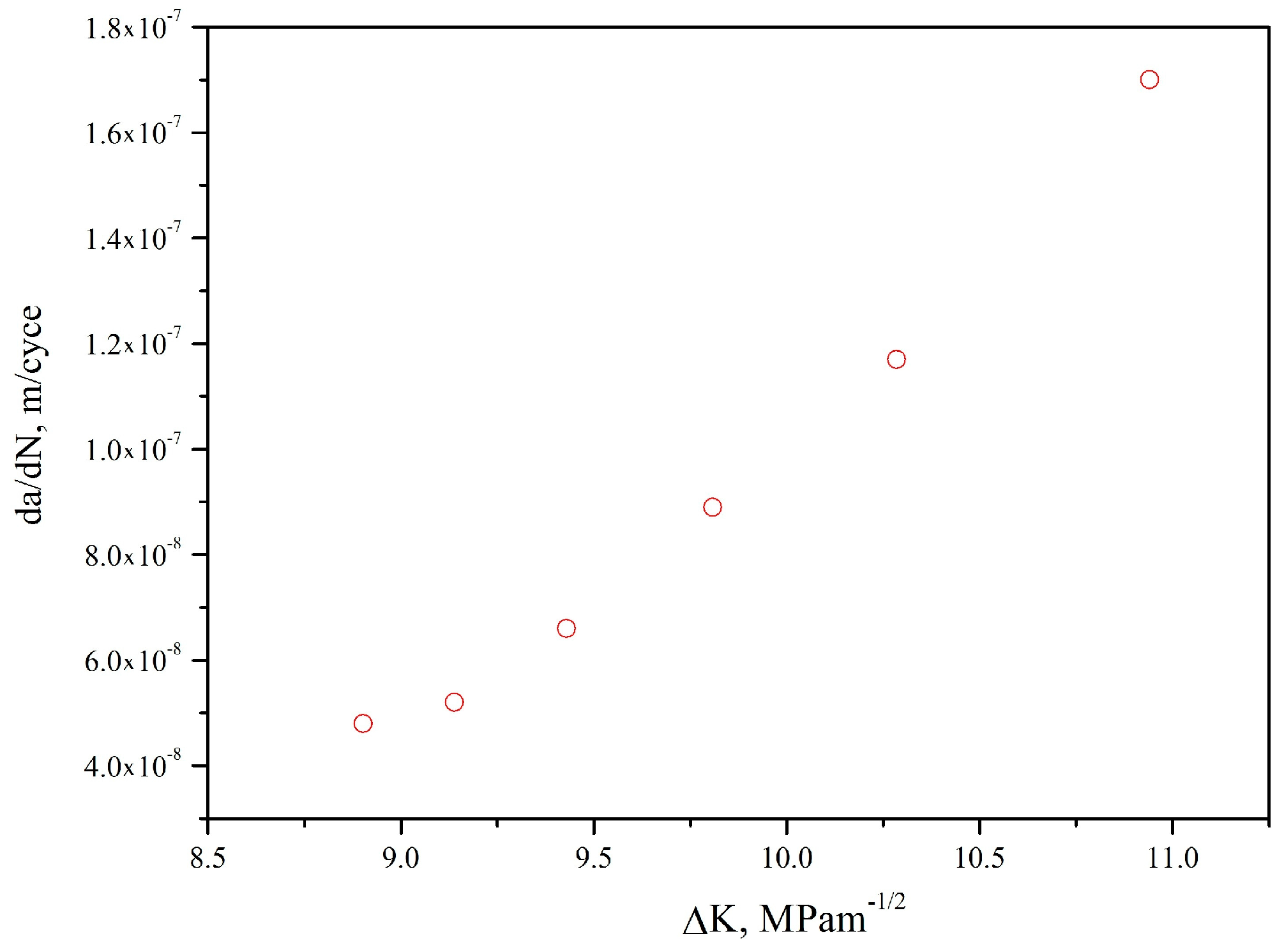
| Predamaged Specimens | Stress Amplitude, MPa | N, Cycles | , µm | , µm | Np, Cycles | Np/N, % |
|---|---|---|---|---|---|---|
| 0% | 460 | 1.590 × 107 | 27.56 | 1487 | 8.008 × 104 | 0.50 |
| 5% | 460 | 3.320 × 105 | 27.56 | 1487 | 8.008 × 104 | 24.12 |
| 10% | 350 | 1.920 × 105 | 42.26 | 2427 | 1.440 × 105 | 74.99 |
| 20% | 300 | 2.000 × 105 | 69.06 | 2650 | 1.706 × 105 | 85.30 |
© 2017 by the authors. Licensee MDPI, Basel, Switzerland. This article is an open access article distributed under the terms and conditions of the Creative Commons Attribution (CC BY) license (http://creativecommons.org/licenses/by/4.0/).
Share and Cite
Nie, B.; Zhao, Z.; Ouyang, Y.; Chen, D.; Chen, H.; Sun, H.; Liu, S. Effect of Low Cycle Fatigue Predamage on Very High Cycle Fatigue Behavior of TC21 Titanium Alloy. Materials 2017, 10, 1384. https://doi.org/10.3390/ma10121384
Nie B, Zhao Z, Ouyang Y, Chen D, Chen H, Sun H, Liu S. Effect of Low Cycle Fatigue Predamage on Very High Cycle Fatigue Behavior of TC21 Titanium Alloy. Materials. 2017; 10(12):1384. https://doi.org/10.3390/ma10121384
Chicago/Turabian StyleNie, Baohua, Zihua Zhao, Yongzhong Ouyang, Dongchu Chen, Hong Chen, Haibo Sun, and Shu Liu. 2017. "Effect of Low Cycle Fatigue Predamage on Very High Cycle Fatigue Behavior of TC21 Titanium Alloy" Materials 10, no. 12: 1384. https://doi.org/10.3390/ma10121384



